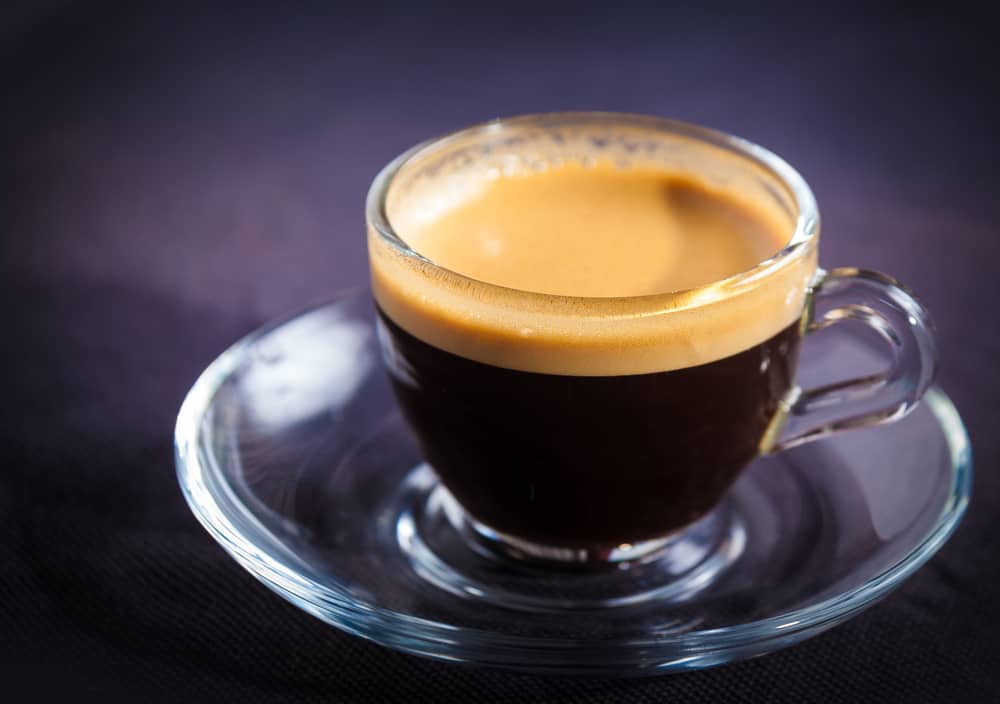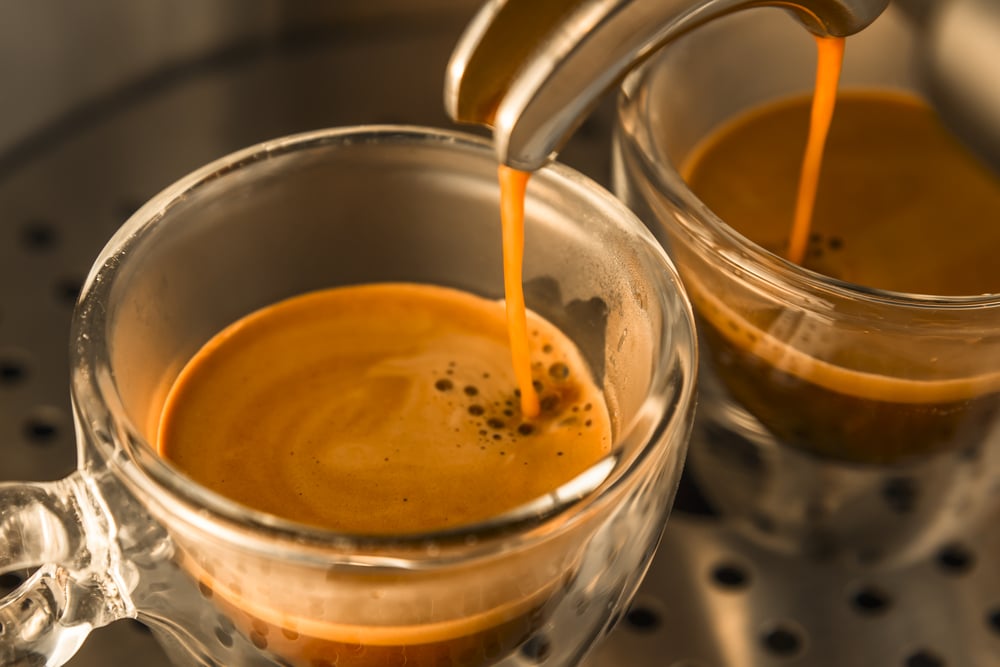What is Coffee Crema?

Espresso crema is the creamy foam atop a well extracted shot of espresso, which is crucial for enhancing flavor. It forms when hot water is pressured through finely ground coffee, mixing coffee bean oils with released carbon dioxide to create bubbles. Crema’s quality and appearance depend on bean type, roast, extraction time, and machine pressure.
A fine espresso crema is thick and foamy and balances bitterness with sweetness. It seals in flavors, aids in latte art, and is a marker of espresso quality, making it cherished by espresso coffee enthusiasts. Whether you prefer a light or dark roast, a well-formed crema enhances your coffee experience.
What Is The Ideal Espresso Crema?
- Thickness: A good espresso crema should be thick and velvety but not overly so. It should have enough body to provide a creamy texture but not so much that it overwhelms the coffee.
- Coverage: The dense crema should cover the entire surface of the espresso. It acts as a protective layer, sealing in the aromas and flavors of the coffee underneath.
- Amount: An ideal espresso shot will contain crema that constitutes roughly 10% to 25% of its total volume to strike a flavor balance.
- Color: The color should typically be a rich, golden brown hue. This color is often used as an indicator of a well prepared espresso.
- Persistence: A beautiful crema should linger on the surface of the espresso for some time after the shot is pulled.
- Taste: The flavor of the crema should complement the underlying coffee. It can have slightly bitter and ashy notes but should not overpower the overall taste.
The ideal amount of crema balances these factors, and it can vary depending on the coffee blend, roast level, and individual preferences. Some espresso enthusiasts prefer a thicker crema, while others prefer a more moderate layer. Experimenting with different factors, such as bean selection and extraction techniques, can help you find the ideal crema that suits your taste.
Why Does Crema Form?
During the roasting process, coffee beans release carbon dioxide trapped inside the bean. When hot water is forced through finely ground coffee in an espresso machine, the pressure causes the carbon dioxide to release as bubbles. These bubbles then rise to the surface, creating the foamy layer called crema.
Surface active agents, such as melanoidins and coffee oils, in the coffee grounds also play a crucial role in crema formation. These agents coat and stabilize carbon dioxide bubbles, ensuring they don’t dissipate too quickly. This coating helps to give the crema its characteristic texture and thickness.
What Does Good Espresso Crema Taste Like?
Coffee crema typically has an ashy, bitter taste. This is due to the presence of carbon dioxide gas that is trapped within the coffee oils and is responsible for the formation of the crema. The darker the roast degree of the coffee, the more pronounced the bitter and ashy flavors.
The taste of crema can also vary depending on the coffee used. Different coffee blends and bean origins can produce different flavor profiles. Some crema may have notes of chocolate, caramel, or even fruity undertones, depending on the coffee and the roasting process.
Stirring the crema into espresso before sipping can even out flavors, reducing bitterness and enhancing balance. However, taste is subjective; some enjoy crema’s bitter and ashy notes, while others may find them overpowering, preferring lighter crema. Crema’s impact on espresso taste varies based on individual preferences.
Why Does Good Crema Matter And What Information Does Crema Hold?
In the espresso world, crema is more than just a garnish on top of your shot – it plays a crucial role in the coffee experience. This delicate layer of foam that forms on the surface of a well made espresso shot is visually appealing and an indicator of a properly extracted and well balanced cup of coffee.
One reason crema matters is its contribution to the flavor profile of espresso. The oils in coffee beans are responsible for the rich and complex flavors we love, and the crema acts as a barrier, holding in those precious oils and protecting them from oxidization. When you stir the crema into the liquid, you allow those flavor packed oils to disperse evenly, resulting in a more harmonious and enjoyable taste.
Crema also affects the mouthfeel and texture of espresso. It adds a velvety and smooth quality to the coffee, enhancing the overall drinking experience. As the crema coats your taste buds, it provides a rich and lingering sensation.
Crema visually demonstrates the barista’s skill in espresso brewing and the coffee’s overall quality. A thick and bubbly crema indicates the espresso shot was properly extracted with the right amount of pressure, temperature, and extraction time. It demonstrates the barista’s skill and attention to detail.
Over Extraction vs. Under Extraction
Over extraction occurs when the coffee is brewed for too long or with too fine of a grind. This can result in an excessive amount of coffee bean oils being extracted, leading to an overly dark and uneven crema. The crema may appear bubbly or have a burnt appearance. This indicates that the coffee has been over extracted, which can result in a bitter and astringent flavor.
On the other hand, under-extraction happens when the coffee is brewed for too short or with too coarse of a grind. This produces a pale and thin crema that quickly dissipates. The under extracted crema indicates weak flavor, as insufficient coffee bean oils have been extracted. The resulting espresso may taste weak and lack the desirable complexity and richness.
Factors That Affect Crema

Coffee Beans’ Quality and Freshness
Coffee quality and freshness are vital to creating a rich and flavorful coffee crema. When freshly roasted coffee makes espresso, it releases carbon dioxide gas. This gas is responsible for creating the beautiful layer of foam that we know as crema.
Use high quality, freshly roasted coffee to ensure the production of ample crema. Also, consider the roast date since coffee beans are at their peak freshness within 7-21 days after roasting. Coffee crema is more likely to be achieved when using beans within this time frame.
Proper storage methods also contribute to the preservation of coffee freshness. Coffee should be stored in airtight containers in a cool and dry place, away from direct sunlight and moisture. This helps to maintain the freshness of the beans, prolonging their release of carbon dioxide when brewed.
Coffee Roast
Darker roasts, such as French or Italian roasts, produce less crema than medium or light roasts. This results from the elevated temperatures and extended roasting durations, which contribute to a more comprehensive extraction of oils from the coffee beans. As a result, less oil is left in the beans to contribute to crema formation.
Medium roasted coffee is often preferred for achieving the ideal crema. This roast level strikes a balance between preserving the coffee bean oils necessary for crema formation and developing the flavors associated with the roasting process. The medium roast’s moderate levels of oils allow for the formation of a rich and flavorful crema layer.
Coffee Processing
The processing method used for the coffee can also impact crema formation. Naturally processed beans, which undergo a dry processing method, typically have more oils and contribute to a richer crema than wet processed beans. The wet processing method can remove some oils, resulting in less crema.
Espresso Machine Type
The type of espresso machine used significantly affects coffee crema. Professional machines in cafes offer precise control with adjustable settings like water flow time, temperature, and pressure. Baristas optimize crema quality through customization. Many at home machines have limited customization due to automatic controls. Some at home modern espresso machine models now offer increased control with programmable options for adjusting extraction settings.
Creating The Perfect Espresso Crema
Creating the perfect crema in a shot of espresso requires attention to several key factors and a precise high pressure brewing method. Here’s how to achieve it:
- Quality Coffee: Start with the best coffee beans for crema and use whole coffee beans roasted explicitly for espresso. Use coffee beans within a few weeks of roasting for the best crema.
- Correct Grind Size: Use a burr grinder to ensure a consistent, fine grind size. The grind should be tailored to espresso, as too coarse or too fine a grind can affect crema quality.
- Tamping Technique: When filling the portafilter basket with coffee grounds, ensure even distribution and level the grounds. Apply firm, consistent pressure when tamping to create a uniform coffee puck. This helps ensure even espresso extraction.
- Water Temperature: Ensure your espresso machine’s water temperature is within the ideal range, typically between 195°F to 205°F (90°C to 96°C). This range optimizes the extraction process.
- Proper Extraction Time: A good shot should be extracted within a specific time frame, typically around 20-35 seconds. For darker roasts, it’s advisable to initiate brew times ranging from 20-25 seconds, while for lighter roasts, consider starting with brew times of 25-30 seconds. Adjust the grind size and dose to achieve this, as too short or too long an extraction can impact crema quality.
- Consistent Pressure: The best espresso machines should maintain consistent pressure throughout the brewing process. Inconsistent pressure can lead to uneven extraction and crema formation. Pressure should be at a minimum of nine bars.
- Clean Equipment: Regularly clean your espresso machine, especially the portafilter and group head. Residue buildup can negatively affect crema.
- Experiment: Fine tuning to create a better crema may require some experimentation with factors like grind size, dose, and extraction time. Keep notes to track your progress.
Remember that achieving the perfect crema can take practice and adjustment. Variables like the type of coffee, roast level, and your specific espresso machine also influence crema formation. With dedication and attention to detail, you can create an espresso with a delicious and visually appealing crema.
Alex is a web developer, writer, and marketer. He has degrees in English, Computer Science, and Mathematics and is always learning as much as he can. Alex operates a series of websites for both client and personal use. Alex usually starts the day with shot of espresso or an Americano and then follows up with a Cafe Au Lait with lunch. He enjoys trying new coffee beans and finding new ways to prepare it, but most days prefers to keep things simple.





